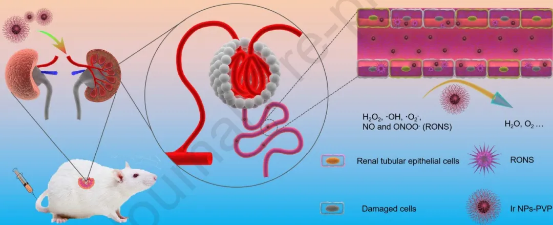Huang Peng Biomaterials of Shenzhen University: Ultra-small iridium nanoenzyme with multiple mimic enzyme activities for the treatment of acute kidney injury
QQ Academic Group: 1092348845
Detailed
Acute kidney injury (AKI) is a kidney disease with high mortality, which is mainly related to high levels of endogenous reactive oxygen species/nitrogen (RONS). However, there is no good clinical treatment plan for the treatment of AKI. The development of antioxidants with high renal enrichment efficiency is an important way to prevent and treat AKI. Nanoenzymes, as a new type of artificial enzymes, have received extensive attention from researchers in the past decade because of their outstanding advantages over natural and traditional artificial enzymes. Professor Huang Peng from Shenzhen University reported on an ultra-small, polyvinylpyrrolidone-coated iridium nanoparticle (Ir NPs-PVP, 1.5 nm) and used it as a nanoenzyme with multiple mimic enzyme activities to remove various RONS.
Key points of this article:
(1) Ir NPs-PVP can produce effective cell protection. At the same time, the results of computed tomography and inductively coupled plasma mass spectrometry showed that after intravenous administration, Ir NPs-PVP can be preferentially enriched in the kidney, thereby effectively alleviating the clinical symptoms of AKI mice induced by rhabdomyolysis or cisplatin.
(2) At the same time, the ultra-small Ir NPs-PVP also showed relatively low systemic side effects in the body, thanks to its rapid elimination through urine. In summary, this work fully proves that ultra-small nanozymes have good clinical transformation potential in the treatment of AKI.

references:
Dong-Yang Zhang. et al. Multi-enzyme mimetic ultrasmall iridium nanozymes as reactive oxygen/nitrogen species scavengers for acute kidney injury management. Biomaterials. 2021
https://www.sciencedirect.com/science/article/pii/S0142961221000570
Key points of this article:
(1) Ir NPs-PVP can produce effective cell protection. At the same time, the results of computed tomography and inductively coupled plasma mass spectrometry showed that after intravenous administration, Ir NPs-PVP can be preferentially enriched in the kidney, thereby effectively alleviating the clinical symptoms of AKI mice induced by rhabdomyolysis or cisplatin.
(2) At the same time, the ultra-small Ir NPs-PVP also showed relatively low systemic side effects in the body, thanks to its rapid elimination through urine. In summary, this work fully proves that ultra-small nanozymes have good clinical transformation potential in the treatment of AKI.

references:
Dong-Yang Zhang. et al. Multi-enzyme mimetic ultrasmall iridium nanozymes as reactive oxygen/nitrogen species scavengers for acute kidney injury management. Biomaterials. 2021
https://www.sciencedirect.com/science/article/pii/S0142961221000570
- Previous: The prospects of singl
- Next: A Rising 2D Star: Nove


 Academic Frontier
Academic Frontier
